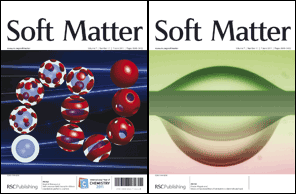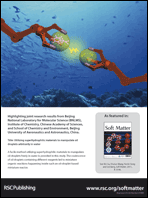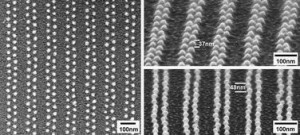 This is the second in a series of blogs looking at the most cited articles in Soft Matter. The first part can be found here. The countdown continues with the top five in the top ten 2010.
This is the second in a series of blogs looking at the most cited articles in Soft Matter. The first part can be found here. The countdown continues with the top five in the top ten 2010.
At number 5… In fifth place, with 14 citations, is ‘Block copolymer multiple patterning integrated with conventional ArF lithography‘. As technology continues to miniaturise, patterning on the nanometre scale (sub 30 nm) is no longer just desirable, but a requirement for semiconductor devices and chips. In this article, Park et al. combine photolithography with the self-assembly of block copolymers to create patterns down to 20 nm in size.
Initially, the photoresist was patterned using the industry standard 193 nm ArF lithography to create an asymmetric pattern. An underlying polymer brush layer was then oxidised and the photoresist washed away. The result was a chemical asymmetric pattern of alternating neutral and polar stripes. The block copolymer was spun onto this and self-assembled to create arrays of standing cylinders aligned with the underlying pattern. Examples can be seen in the image above. These block copolymers were then used as templates to create arrays of nanodots and nanopillars. This method provides a simple way to pattern on the sub 20 nm scale and avoids multiple photolithography steps or switching to shorter wave-length light sources.
The citing articles all look at patterning on the nanoscale. One article worth highlighting is that of Lee et al. published in Adv. Funct. Mater. This article reviews tailored and self-assembly of carbon nanotubes and graphene to form 3D patterns. Park’s block copolymer templates offer a way to direct the growth of nanotubes into well-ordered arrays. Graphene has also been used to chemically modify surface energy. Deposition of block copolymers onto these graphene films results in highly aligned perpendicular lamellae, which can then be used for patterning.
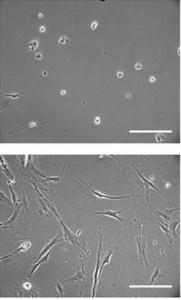
Difference is number and morphology of cells for soft and hard surfaces.
At number 4… Next up, with 15 citations, is ‘Spatially controlled hydrogel mechanics to modulate stem cell interactions‘. This is the third (but not final) appearance of hydrogels in the top ten 2010. The focus of the paper is on how hydrogel properties affect the spreading and proliferation of human mesenchymal stem cells. Understanding this behaviour has importance and relevance in tissue engineering and cellular behaviour in disease states.
The morphology and proliferation of the stem cells were seen to be highly dependent on the underlying hydrogel. Increased spreading and growth was seen for stiffer hydrogels. Wang et al. have gone on to show that stiffer surfaces also result in more organised cytoskeletons, more stable focal adhesion and faster migration of the stem cells. In addition, gene expression was seen to differ for cells cultured on soft and hard hydrogels. On the softer hydrogels, neuron specific proteins were expressed by the cells, while on stiffer hydrogels there were not. Instead the cells expressed myogenic proteins. Very recently, Huang et al. proposed a mechno chemical coupling model to explain the dependence of spreading and adhesion on substrate stiffness.
At number 3… In 3rd place is ‘Nematic phases of bent core mesogens‘ with 16 citations. This paper by Keith et al., looks at the chain-length and temperature dependence of the phase behaviour of bent core mesogens. These mesogens, derived from 4-cyanoresorcinol with terminal alkyl chins, display broad metastable nematic phase ranges at ambient temperatures and do not have smectic low temperature phases. The authors suggest that mixtures of these compounds may potentially give rise to bent-core materials with stable nematic phases at room temperature.
At number 2… In second place is ‘In pursuit of propulsion at the nanoscale‘ by Stephen Ebbens and Jonathon Howse with 20 citations. Both authors are both currently at the University of Sheffield, UK. This review article looks at the developments in self-propelling nano and micro-scale swimming devices, with emphasis on swimming transporters. Ideally these swimmers should operate independently, without an external stimulus. Ebbens and Howse focus on bi-metallic nano-rod swimmers, which have been demonstrated to transport cargo. This was also discussed in a mini-review by Pumera.
Tierno et al. have shown that paramagnetic catalytic microellipsoids can be guided using external magnetic fields. Their particles align along the field and are seen to travel perpendicularly to the field in an almost straight trajectory. For spherical particles this is not the case. Sanchez et al. have developed autonomous hybrid biocatalytic microengines. These engines use enzymes as their catalysts and are able to achieve speeds of 10 body lengths per second. In a second paper, Sanchez et al. demonstrated the transportation of cells using microbots. However, while the microbots were self propelled, loading transporting and delivery of the cells was externally controlled. I should mention that the two papers by Sanchez discuss very different swimmers. It is clear that this is currently a very hot area or research, due in part to their wide ranging potential medical applications.
Number 1… And finally, at the top of the top ten 2010 is ‘Responsive reversible hydrogels from associative “smart” molecules‘, published online in February 2010. The review article by Constantinos Tsitsilianis looks at the reversible hydrogels through self-assembly and association mechanisms.
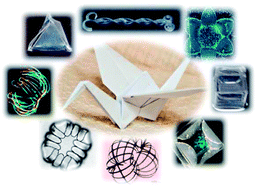 Read these Hot Articles for free until 8 July…
Read these Hot Articles for free until 8 July…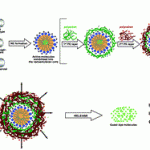 orly water-soluble drugs exhibited a narrow size distribution, which makes them potential candidates for nanocarriers in cancer therapy. Surfactant structure was compared with nanocapsule stability and the number of polyelectrolyte layers required to create exetremely long-term sustained release of active molecules determined. Urszula Bazylińska, Renata Skrzela, Krzysztof Szczepanowicz, Piotr Warszyński and Kazimiera A. Wilk, Soft Matter, 2011, DOI: 10.1039/C1SM05395G
orly water-soluble drugs exhibited a narrow size distribution, which makes them potential candidates for nanocarriers in cancer therapy. Surfactant structure was compared with nanocapsule stability and the number of polyelectrolyte layers required to create exetremely long-term sustained release of active molecules determined. Urszula Bazylińska, Renata Skrzela, Krzysztof Szczepanowicz, Piotr Warszyński and Kazimiera A. Wilk, Soft Matter, 2011, DOI: 10.1039/C1SM05395G











